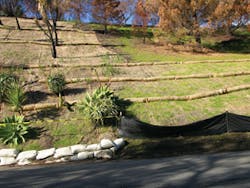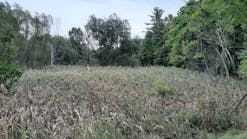Phase II of National Pollutant Discharge Elimination System (NPDES), which has been in effect in most states since 2003, regulates construction-site discharges and is one of the driving forces for contractors and developers to put best management practices (BMPs) in place on their sites. BMPs such as silt fences, straw wattles, other barriers, and inlet protection devices prevent muddy water from flowing off the site or into nearby storm drains. Violations can result in large fines or stop-work orders.
While some developers draw up the required stormwater pollution prevention plans (SWPPPs) for their own sites, others hire contractors who specializes in erosion and sediment control to write the SWPPP, install the BMPs, and perform periodic inspection and maintenance until construction is finished.
In addition, the EPA issued a final version of its effluent limitations guidelines for construction-site discharges in December 2009, regulating the amount of turbidity in the water that leaves construction sites. The guidelines apply to sites 10 acres and larger. For some sites, it is likely that the usual sediment control BMPs, such as silt fences, won’t be enough. In these cases, sites may have to use “active treatment systems,” such as filtration systems with some sort of flocculant or polymer to help the fine clay particles settle out of the runoff.
Sediment Control Challenges
According to Eileen Straughan, president of Straughan Environmental Services in Columbia, MD, sediment control has long been recognized as a challenge on large-scale construction sites. The company provides environmental management services, including erosion control, sediment control, stormwater services, and environmental permitting for major construction projects.
“What has not been as widely recognized is that sediment is a pollutant and is, in fact, one of the leading causes of water-quality impairment nationwide,” she says.
As the new effluent limitation guidelines (ELGs) go into effect, it will become critical for construction site managers and owners to educate themselves on the science and technologies that monitor and treat stormwater discharge. According to Straughan, the addition of an onsite environmental manager can help protect construction businesses and ensure their compliance with the new regulations.
The new ELGs erosion and sediment control plans more important than ever. In bidding jobs, contractors need to understand the details behind the erosion and sediment control plan and bid it correctly. For example, they need to understand that the devices in the plan, such as a stabilized construction entrance, may need to be constructed more than once, depending on the length of construction, and this work needs to be included in the bid. “Some of the devices are also going to need to be actively maintained on the site, so include the cost of inspection and maintenance in the bid,” says Straughan. It is also important to include the cost of water-quality monitoring devices. These devices determine the turbidity levels of water coming into the construction site, as well as the levels going out, to help determine whether the erosion and sediment control devices are effective.
While contractors need to keep the new legislation in mind, it is important not to forget the old. “The fundamental legislation is the Clean Water Act,” she notes. “Stormwater has been regulated under this federal statute for a long time.”
Maryland has had erosion and sediment control legislation on the books for many decades. There is a general permit for construction activities that continues to be revised. “The most recent revision was 2009, which also incorporates environmental site design requirements for sediment and erosion control on construction sites,” states Straughan.
I-95 Toll Lane Project
Since Straughan Environmental Services has been involved in sediment and erosion control for so long in Maryland, it continues to update its guidelines and practices. One project it has been working on is the I-95 Express Toll Lanes project just outside of Baltimore. This project has deployed water-quality monitoring devices that continuously monitor turbidity levels in the receiving streams to determine whether the erosion and sediment control devices are fulfilling their objectives in controlling sediment from the construction site.
The Maryland Transportation Authority has arranged for construction of a project that is adding electronic toll lanes to I-95 in Baltimore. “We are doing the environmental compliance and permitting for the project,” states Straughan. Erosion and sediment control has been an issue on the project.
According to Straughan, David LaBella, the project manager, has been a strong advocate for making sure that all of the inspections and maintenance of sediment control devices are taken care of. “This is a 10-mile-long project with three major interchange reconstruction areas,” explains LaBella. “In fact, one of the most challenging aspects of the project relates to sediment control at these three interchanges.” For example, at the I-95 and I-695 interchange, the soil on which the road is being built is high-clay-content material. Preventing soil from entering streams has been a challenge, according to LaBella. Adding to the challenge is that many of the months in 2009 were much wetter than usual.
The project team has come up with a number of strategies to manage sediment. One has been the installation of double-row silt fences. “However, these simply work as filters,” explains LaBella.
Another solution has been to stabilize the work areas. “For example, we seed whenever we can in order to stabilize,” he says. The workers have also built berms.
Another strategy has been to build ponds and to dewater them before they get more than half full. “We transport water from one site to another to keep the ponds empty,” he says.
While the technical endeavors have been important, LaBella considers the commitment of the personnel to be critically important. “We have many environmental controls in place from a personnel standpoint,” he states. These include:
- An erosion and sediment control inspector on each individual contract for the project
- The contractor’s erosion and sediment control inspector
- A project-wide environmental manager
- A quality assurance (QA) environmental inspector who monitors the activities of the contractor to make sure that the limits of disturbance and the BMPs are being followed
- An independent environmental monitor, who works on behalf of the environmental agency
“All of these people meet on a regular basis, daily and weekly, and also report frequently to each other,” says LaBella.
The efforts have been working. The project team has established an area at one of the streams near the interchange where it has installed water quality monitors. “We have noticed that we have been able to keep the turbidity levels within the limits of the project at acceptable levels for the most part,” notes LaBella. Overall, he says, the QA inspector has been able to assign very high grades (As and Bs) to the project as it relates to sediment control.
However, the team wants to improve even more in how it deals with the challenges during the project. “We have approached the environmental agencies we are working with, which is the US Army Corps of Engineers, and are discussing the possibility of implementing a flocculent system on an as-needed basis,” he says. “This is a water filtration process that would treat and clean sediment-laden water before the water enters the streams.”
Working in a Quiet Zone
Silt Busters Inc. of Sycamore, IL, is a full-service erosion and sediment control company whose work includes installing silt fences, inlet protection, tree protection fencing, and erosion blankets and performing bank stabilization. The company also does some stormwater pollution prevention plans.
Recently, the company was involved with the new Lake Forest Hospital expansion in Grayslake, IL. The project was unusual in that it involved sediment control and tree protection sensing. “We didn’t do any actual seeding, blanketing, or stabilization,” explains Dan Haug, president.
There were a number of challenges. First, the project occurred during the fall of 2009, a time with a significant amount of rainfall. “We were having to deal with a lot of wet conditions and slopes,” says Haug. “In fact, weather was the biggest challenge.”
The second significant challenge related to wetlands. “There were a lot of wetlands on the project, so we had to protect these,” he says. Third was the protection of many trees that were important to the hospital. Finally, because it was an expansion of an existing hospital, there was a great deal of other activity at the site, with doctors, nurses, staff, and patients going in and out.
To address the challenges, Silt Busters first made some recommendations on alternate locations for the fence in certain areas. “We based these recommendations on our experience of how we realized that water flowed across the site,” states Haug.
The company installed standard GTF190 fabric for the silt fence material. “However, we also used steel posts and wire backing, and the posts had 5-foot spacing,” says Haug. “As a result, it was quite indestructible.”
To install the fence, the company used a Burchland Manufacturing silt fence installer. “We have used the machinery of several of the manufacturers at one time or another,” points out Haug. “However, Burchland is on the top of my list and my crew’s list of the machine they like to use the most. We do use the other machines in certain terrains, though.” Silt Busters used Kubota tractors for the project. Typically, the workers pulled the Burchland installer behind the tractors, rather than using a skid loader. “We like this method better, because we have more control,” he explains. “With a skid loader, you would have to pull it backward.”
Because there were a lot of wetlands on the project, Silt Busters installed several areas of double-row fencing. “This was a challenge, because we had to work in a very tight area of installation, plus having to the two rows,” notes Haug.
In addition, since the hospital had a lot of trees that were important to them, Silt Busters also installed dripline tree protection fencing.
To address the final challenge-working around a busy hospital-the company made sure the workers travelled in the same areas. “There were a lot of people coming and going, so we didn’t want to have a mess around them, to minimize disruption,” says Haug.
The project was handled in multiple phases over several weeks, so Haug and his employees were on- and offsite quite a bit. “Because of the wetter weather, we had to pay attention to dirt that got on the roads and streets and make sure that we were cleaning that up properly behind us,” he continues.
Overall, the project was considered a success. “We got compliments from the companies we worked for related to the fact that the products were heavy duty, that things were installed properly, and that we did the proper cleanup,” he concludes.
Industrial Plant Remediation
An old problem was solved in a new way recently in western Pennsylvania. The ground around a closed industrial plant in Ellwood City in Lawrence County posed a potential health hazard to the local residents. The plant had operated from 1954 to 1969, processing vermiculite that was contaminated with naturally occurring asbestos fibers.
The Agency for Toxic Substances and Disease Registry (a federal agency and division of the Centers for Disease Control and Prevention) studied the site and determined that, in the interest of future public safety, remediation was necessary.
Kemron Environmental Services Inc., an environmental consulting and remediation firm in Vienna, VA, was brought in to handle the project. Kemron has been involved in hundreds of projects involving the assessment, testing, analysis, and cleanup of contaminated sites for both the government and private industry.
The remediation work proceeded smoothly during the summer and fall of 2009. However, when it came to the steep slope located directly behind the main plant building, Kemron’s project manager quickly recognized a logistical problem. Although the plan called for the contaminated 20,000-square-foot slope to be stabilized with a thick layer of topsoil and permanent vegetation, excavating machines could access only the top of the steep slope. In addition, an active railroad track was located just beyond the bottom of the slope. To further complicate matters, only highly trained workers in full-body protective suits were allowed in the area. No machines or outside personnel were allowed on the slope.
At this point, ACF Environmental Services was called in to help assess the situation and recommended a product manufactured by Weaver Express-a “modular” version of the compost-based Filtrexx EdgeSaver. “The modular EdgeSaver was delivered to the job site on pallets,” reports Kevin Weaver of Weaver Express, which specializes in erosion control, including sediment control and steep-slope stabilization. “Each section was a 5-foot-long, 9-inch-diameter Filtrexx SafetySoxx, filled with Filtrexx Growing Media and preloaded with the appropriate seed mix.”
“Because each section could be carried and placed by hand, the modular EdgeSaver was great for stabilizing areas that couldn’t be handled with machines,” adds Greg Paul of ACF Environmental.
While the contaminated slope was being prepared, 170 pallets of product were being delivered to the site staging area. Small brush and weeds were removed by hand, ensuring minimal earth disturbance. No regrading of the slope was performed. Because each modular EdgeSaver section was easily bendable, conforming to the uneven contour of the slope was no problem.
While installing the product, Kemron workers came up with an interesting innovation. They used a 12-inch N-12 stormwater pipe to “slide” each EdgeSaver section from the top of the slope to the installation location, where another worker would put it in place and anchor it. This technique allowed Kemron workers to stabilize the entire slope in a few days. Because the work was done in the fall, full and permanent vegetative cover did not appear on the slope until the following spring.
Reelfoot Lake
Erosion Control Services of Milan, TN, recently worked on a project to manage sediment around a lake area. The Reelfoot Lake Spillway Mitigation Project was a Tennessee Department of Transportation project, and Erosion Control Services was hired as a subcontractor. The project was managed by ETI Corp. of Memphis, TN, an engineering, surveying, land planning, and landscape architecture firm. The goal of the project was to add a new wetland mitigation area for Reelfoot Lake to keep the sediment out of the lake.
“We installed a double-run of wire-backed silt fence on the perimeter of the site,” reports Charles Alexander, owner of Erosion Control Services. He used the tommy Silt Fence Machine from Devon Distributing in Ankeny, IA. “We installed straw in between the two runs of silt fence,” he says. “We then mixed polymer powder with the straw.”
One challenge was the weather. “Last year, we had one of the wettest summers we have had in a long time,” he says. “This made things really muddy and wet during the project.” However, according to Alexander, the tommy machine performed well despite the weather. “We didn’t have any problems at all with the installation.”
Hydroseeding
Hydro-Plant Inc. of San Marcos, CA, is a full-service hydroseeding and erosion control company. It utilizes Hydrosorb products, both dry and emulsified/liquid types, to reduce turbidity in runoff. “We have been in business over 30 years and perform all aspects of hydraulic application of soil stabilizers that improve sediment control,” reports Rob McGann, vice president. “However, we don’t get involved in structural control strategies.”
The company uses different types of hydraulic soil stabilizers; various types of binders, including mulch and guar and bonded fiber matrix, and stabilized fiber matrix, depending on the needs of the project. “In advance, we need to determine the duration of the time they need the product on the site to give them adequate protection, so we can select the right product for erosion and sediment control,” he adds. Hydro-Plant also uses different products based on whether the areas are flat or sloped.
There are different strategies for different soil types, too. “For example, if we are dealing with sandy materials, we might use increased rates of different products,” states McGann. “On some projects, we make this decision.” On other projects, an engineer or designer may make this determination.
Construction Projects
Posillico of Farmingdale, NY, provides civil and environmental construction services, as well as consulting and development. On many projects, the company uses Dandy Bags, manufactured by Dandy Products. “A lot of the projects we do have contract requirements that we use bags for protection,” explains Adam Sobotka, project manager.
Posillico is currently working on a bridge project. “It has about 50 existing catch basins, and we cover the basins with Dandy Bags,” states Sobotka. “We have found them to be very easy to install.” Each bag has straps, which are designed for easy handling and removal the bags.
The bridge project is proceeding smoothly. It began in the spring of 2009 and needs to be completed by the fall of 2011. “However, we expect to be completed by the end of 2010,” he reports.






